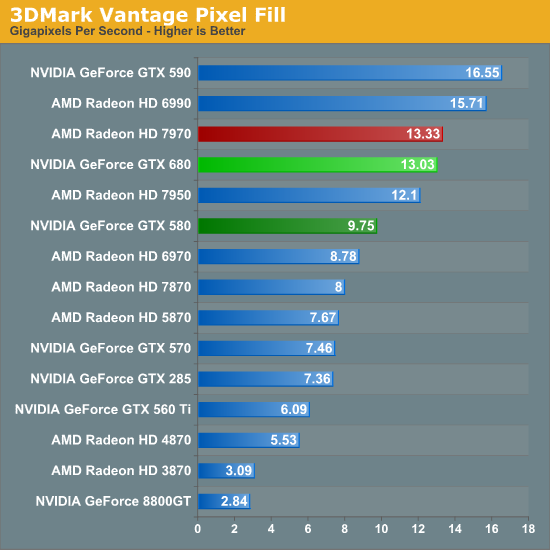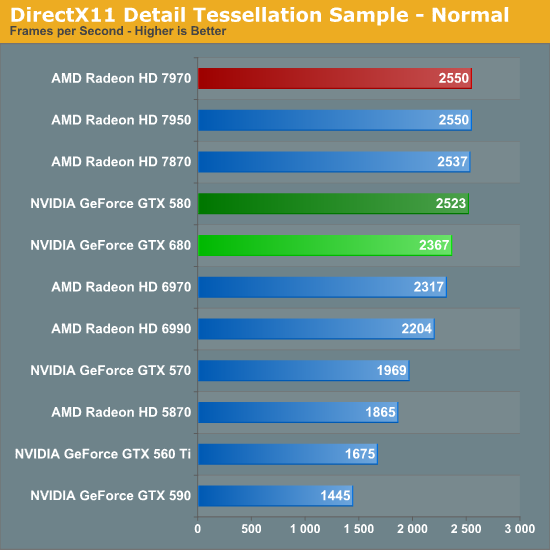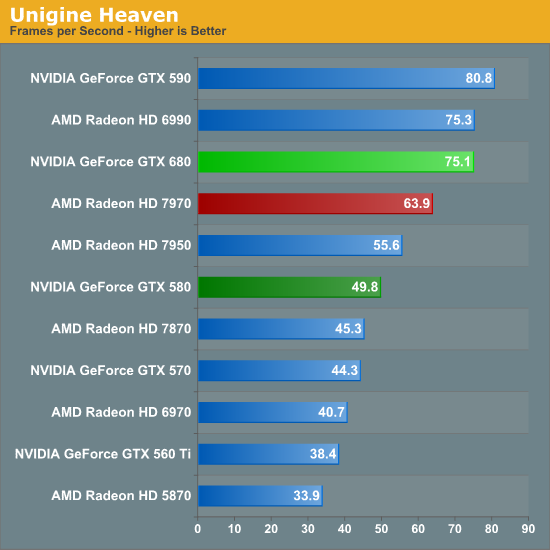NVIDIA GeForce GTX 680 Review: Retaking The Performance Crown
by Ryan Smith on March 22, 2012 9:00 AM ESTTheoreticals
As with any new architecture, we want to take a few moments to look at theoretical performance. These numbers shouldn’t be taken too seriously for cross-vendor comparison, but these numbers often tell us more about interesting architectural improvements that occur from one generation to the next.

Our first theoretical test is perhaps the most perplexing: 3DMark Vantage’s pixel fill test. Typically this test is memory bandwidth bound as the nature of the test has the ROPs pushing as many pixels as possible with as little overhead as possible, which in turn shifts the bottleneck to a mix of ROP performance and the memory bandwidth needed to feed those ROPs.
Compared to the GTX 580, the GTX 680 has almost exactly the same amount of memory bandwidth (192GB/sec) and only 86% of the theoretical ROP performance (37Gpix vs. 32Gpix). In short, it shouldn’t outperform the GTX 580 here, and yet it outperforms the 580 by 33%.
Why does it do this? That’s the hard thing to answer. As we mentioned in our look at GK104’s architecture, NVIDIA did make some minor incremental improvements to their ROPs coming from GF114, such as slightly improved compression and improved polygon merging. One of those may very well be the contributing factor, particularly the compression improvements since this is a typically memory bandwidth bottlenecked test. Alternatively, it’s interesting to note that the difference between the two video cards is almost identical to the difference in the core clock. GTX 560 Ti’s results tend to blow a hole in this theory, but it bears consideration.
In any case, it’s an interesting turn of events and hopefully one that isn’t simply an edge case. As we’ve seen in our benchmarks GTX 680 has strong performance – even if its lead compared to the 7970 diminishes with resolution – but compared to the GTX 580 in particular it needs strong ROP performance across all games in order to deliver good performance at high resolutions and anti-aliasing.

Our second theoretical test is 3DMark Vantage’s texture fill test, which to no surprise has the GTX 680 handily clobbering all prior NVIDIA cards. NVIDIA’s inclusion of 128 texture units on GK104 versus 64 on their previous generation GPUs gives the GTX 680 far better texturing performance. The 30%+ core clock difference only serves to further widen the gap.


Our third theoretical test is the set of settings we use with Microsoft’s Detail Tessellation sample program out of the DX11 SDK. Overall while NVIDIA didn’t make any significant changes to their tessellation hardware (peak triangle rate is still 4/cycle), they have been working on further improving performance at absurdly high tessellation factors. You can see some of this in action at the max factor setting, but even then we’re running into a general performance wall since the Detail Tessellation program can’t go to the absolute highest tessellation factors NVIDIA’s hardware supports.

Our final theoretical test is Unigine Heaven 2.5, a benchmark that straddles the line between a synthetic benchmark and a real-world benchmark as the engine is licensed but no notable DX11 games have been produced using it yet. In any case the Heaven benchmark is notable for its heavy use of tessellation, which means it’s largely a proxy test for tessellation performance. Here we can see the GTX 680 shoot well ahead of the GTX 580 – by more than we saw in the DX11 Detail Tessellation sample – but at the same time there’s a lot more going on in Heaven than just tessellation.
Honestly at this point in time I’m not sure just how much more tessellation performance is going to matter. Until DX11 is the baseline API for games, tessellation is still an add-on feature, which means it’s being used to add fine detail to specific models rather than being used on everything in a game world. This demands good tessellation at high factors but at the same time it’s subject to diminishing returns on the improvement to image quality as triangles reach single pixel sizes and smaller. To that end I’m still waiting to see the day where we see tessellation scale similarly to textures – that is by using full MIP chaining of displacement maps – at which point we can evaluate tessellation performance similar to texture performance when it comes to both measuring the performance hit and evaluating the difference in image quality.










404 Comments
View All Comments
Targon - Thursday, March 22, 2012 - link
Many people have been blasting AMD for price vs performance in the GPU arena in the current round of fighting. The thing is, until now, AMD had no competition, so it was expected that the price would remain high until NVIDIA released their new generation. So, expect lower prices from AMD to be released in the next week.You also fail to realize that with a 3 month lead, AMD is that much closer to the refresh parts being released that will beat NVIDIA for price vs. performance. Power draw may still be higher from the refresh parts, but that will be addressed for the next generation.
Now, you and others have been claiming that NVIDIA is somehow blowing AMD out of the water in terms of performance, and that is NOT the case. Yes, the 680 is faster, but isn't so much faster that AMD couldn't EASILY counter with a refresh part that catches up or beats the 680 NEXT WEEK. The 7000 series has a LOT of overclocking room there.
So, keep things in perspective. A 3 percent performance difference isn't enough to say that one is so much better than the other. It also remains to be seen how quickly the new NVIDIA parts will be made available.
SlyNine - Thursday, March 22, 2012 - link
I still blast them, I'm not happy with the price/performance increase of this generation at all.Unspoken Thought - Thursday, March 22, 2012 - link
Finally! Logic! But it still falls on deaf ears. We finally see both sides getting their act together to get minimum features sets in, and we can't see passed our own bias squabbles.How about we continue to push these manufactures in what we want and need most; more features, better algorithms, and last and most important, revolutionize and find new way to render, aside from vector based rendering.
Lets start incorporating high level mathematics for fluid dynamics and the such. They have already absorbed PhysX and moved to Direct Compute. Lets see more realism in games!
Where is the Technological Singularity when you need one.
CeriseCogburn - Thursday, March 22, 2012 - link
Well, the perspective I have is amd had a really lousy (without drivers) and short 2.5 months when the GTX580 wasn't single core king w GTX590 dual core king and the latter still is and the former has been replaced by the GTX680.So right now Nvidia is the asbolute king, and before now save that very small time period Nvidia was core king for what with the 580 .. 1.5 years ?
That perspective is plain fact.
FACTS- just stating those facts makes things very clear.
We already have heard the Nvidia monster die is afoot - that came out with "all the other lies" that turned out to be true...
I don't fail to realize anything - I just have a clear mind about what has happened.
I certainly hope AMD has a new better core slapped down very soon, a month would be great.
Until AMD is really winning, it's LOSING man, it's LOSING!
CeriseCogburn - Thursday, March 22, 2012 - link
Since amd had no competition for 2.5 months and that excuses it's $569.99 price, then certainly the $500 price on the GTX580 that had no competition for a full year and a half was not an Nvidia fault, right ? Because you're a fair person and "finally logic!" is what another poster supported you with...So thanks for saying the GTX580 was never priced too high because it has no competition for 1.5 years.
Unspoken Thought - Saturday, March 24, 2012 - link
Honestly the only thing I was supporting was the fact he is showing that perspective changes everything. a fact exacerbated when bickering over marginal differences that are driven by the economy when dealing with price vs performance.Both of you have valid arguments, but it sounds like you just want to feel better about supporting nVidia.
You should be able to see how AMD achieved its goals with nVidia following along playing leap frog. Looking at benchmarks, no it doesn't beat it in everything and both are very closely matched in power consumption, heat, and noise. Features are where nVidia shine and get my praise. but I would not fault you if you had either card.
CeriseCogburn - Friday, April 6, 2012 - link
Ok Targon, now we know TiN put the 1.3V core on the 680 and it OC'ed on air to 1,420 core, surpassing every 7970 1.3V core overclock out there.Furthermore, Zotac has put out the 2,000Ghz 680 edition...
So it appears the truth comes down to the GTX680 has more left in the core than the 7970.
Nice try but no cigar !
Nice spin but amd does not win !
Nice prediction, but it was wrong.
SlyNine - Thursday, March 22, 2012 - link
Go back and look at the benchmarks idiot. 7970 wins in some situations.SlyNine - Thursday, March 22, 2012 - link
In Crysis max, 7970 gets 36 FPS while the 680 only gets 30 FPS.Yes, some how the 7970 is losing. LOOK AT THE NUMBERS, HELLO!!???
Metro 2033 the 7970 gets 38 and the 680 gets 37. But yet in your eyes another loss for the 7970...
7970 kills it in certian GPU Compute, and has hardware H.264 encoding.
In a couple of games, which you already get massive FPS with both, the 680 boasts much much higher FPS. But than in games where you need the FPS the 7970 wins. Hmmm
But no no, you're right, the 680 is total elite top shit.
eddieroolz - Friday, March 23, 2012 - link
You pretty much admitted that 7970 loses in a lot of other cases by stating that:"7970 kills it in certain GPU compute..."
Adding the word modifier "certain" to describe a win is like admitting defeat in every other compute situation.
Even for the games, you can only mention 2 out of what, 6 games where 7970 wins by a <10% margin. Meanwhile, GTX 680 proceeds to maul the 7970 by >15% in at least 2 of the games.
Yes, 7970 is full of win, indeed! /s